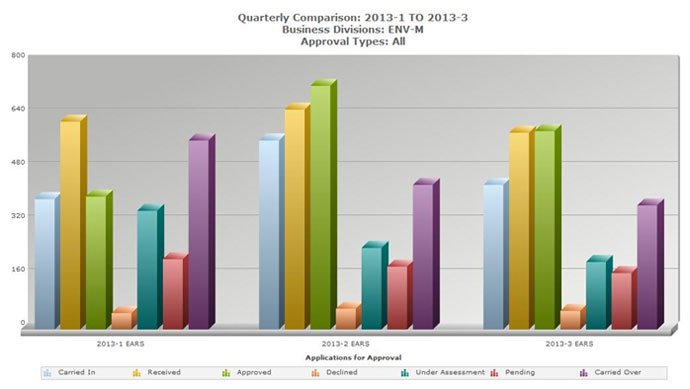Director's foreword

Executive Director, Environment, Phil Gorey
The Mining Rehabilitation Fund (MRF) was formally launched on 1 July for its first voluntary year. Response to the MRF has been well beyond expectations, with around $5 million voluntarily paid as levies so far this year. These voluntary payments have enabled the Department of Mines and Petroleum (DMP) to retire nearly $230 million in unconditional performance bonds at a time when investment money in the industry is tight.
We recently celebrated the annual Golden Gecko awards, with ESS Support Services Worldwide and AshOil winning a Golden Gecko. Their story can be seen below and is an excellent example of innovation and reuse of an otherwise nasty waste resource.
Over the last quarter, DMP’s Environment Division began the induction of the final few positions in its new organisational structure. The Environment Division is approaching its full capacity and we are gaining a greater ability to respond and service industry and the community.
If you have any concerns regarding DMP’s new environmental regulations, we encourage you to raise these directly with the team leader that manages the area your project falls under. This will enable the Environment Division to deal with these in an efficient and timely manner.
Team leader contact details can be found here.
As this will be the final eNewsletter for 2013, I would like to take this opportunity to wish you all, and your family and friends, a safe and happy holiday season.
Golden Gecko Awards 2013
This year's Golden Gecko award was taken out by a Tom Price-based project which recycles used cooking oil from mining camps into renewable biodiesel fuel. The award was won by ESS Support Services Worldwide and AshOil, a wholly owned subsidiary of the Ashburton Aboriginal Corporation.
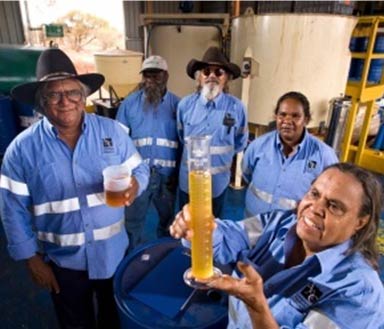
Tom Price AshOil directors Phil Carey, Doris Parker, Charlie Hyland, Trevor Park, Coomie Miller.
AshOil provides a sustainable way of offsetting diesel produced by mining companies by collecting cooking oil from mining camps throughout the Pilbara region and converting it into bio diesel and a by-product called glycerol. The glycerol by-product is used to develop products such as bio-degradable dust suppressant, truck and hand wash.
AshOil signed a formal agreement in 2010 with ESS, who run the camps, to ensure all the cooking oil in their mining camps would be converted to biodiesel. There is an abundant supply of cooking oil in the Pilbara region from mining camps and this is a way of utilising a waste locally in the region and producing a renewable product that offsets diesel so it reduces emissions in the Pilbara region.
Ashburton Aboriginal Corporation enterprise manager Stuart Gunzburg said to the West Australian "It is recognition that indigenous organisations can carry out sustainable business processes and develop good relationships with organisations and produce sustainable partnerships. AshOil has indigenous links, so anywhere that we go to replicate the process we'd like to have an indigenous involvement, primarily in training and development of indigenous employment opportunities."
Mines and Petroleum Minister Bill Marmion said "AshOil recycled about 200,000 litres of used cooking oil per year, the project reduced carbon emissions by about 500 metric tonnes, the equivalent of taking 100 cars permanently off the road".
He said the project also uses waste products from producing biodiesel to develop other products, such as dust suppressant, which has the potential to save large amounts of water.
The companies have produced a short documentary on the project.
The event also recognised Franmarine Underwater Services Pty Ltd and the Department of Fisheries with a Certificate of Merit. Franmarine and the Department of Fisheries have designed a system to trial the in-water eradication of marine bio-fouling of large marine vessels.
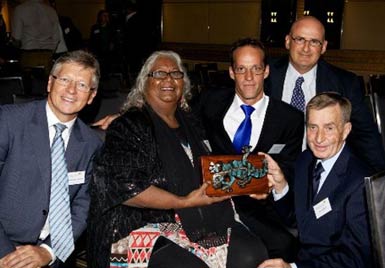
Mines and Petroleum Minister Bill Marmion with Golden Gecko winners: Margaret Parker, Piers Austin, Stuart Gunzberg and Darryl Milburn from AshOil.
Mr Marmion said "The system promotes a preventative risk-management approach to biosecurity, and a 'clean-hull' operating policy for WA and Australian waters. This project and technology shows great innovation exists outside and above the industry standards, and sets a precedent for in-water hull cleaning."
A documentary by Franmarine Underwater Services explains in more detail the importance of hull cleaning and how the system works.
This year's Golden Gecko award finalists were:
- ESS Support Services Worldwide and AshOil
- Franmarine Underwater Services Pty Ltd and the Department of Fisheries
- Newmont Mining Corporation, Central Desert Native Title Services and Biota Environmental Sciences
- Rio Tinto Iron Ore
- Rio Tinto Iron Ore and Sinclair Knight Merz.
New updates to chemical disclosure
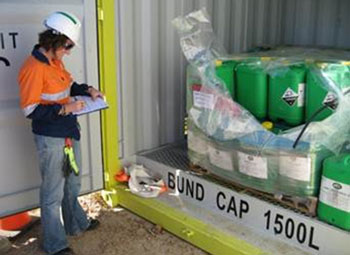
An environmental officer inspects chemicals being stored on a petroleum site.
The Department of Mines and Petroleum recently updated its public disclosure rules for chemicals being used down-hole in petroleum activities. Chemical disclosure is a requirement of the Petroleum Environment Regulations gazetted in August 2012.
The chemical disclosure guidelines were released last year in conjunction with the regulations to ensure transparency in relation to chemicals being used in petroleum activities, whether offshore or onshore.
The guidelines were updated in August following an extended period of stakeholder feedback and consultation.
Chemical disclosure is now moving towards a risk-based approach, which means that more information has to be provided to DMP about the chemicals being used. Petroleum operators may also be required to undertake a specific chemical risk assessment for any proposed activities where potential impacts or risks to human health, the environment or water resources are identified.
DMP uses the chemical disclosure and risk assessment in its regulatory environmental approvals process to help determine the acceptability of a proposed petroleum activity. This may include obtaining advice from other agencies on a case-by-case basis, such as the Department of Water and Department of Health. It may also include referring the proposal to the Environmental Protection Authority where it is deemed to have significant environmental impacts or risks. The updates include:
- adopting 'systems based' chemical disclosure which means that disclosure is provided for each stage of a petroleum activity, ie. drilling, cementing, well maintenance and fraccing stages (where appropriate);
- providing information about ecotoxicity (in relation to aquatic plants and animals) and rates of biodegradation;
- providing a chemical disclosure template for operators to use in a consistent manner; and
- releasing a Petroleum Fact Sheet on DMP's website about chemicals in the petroleum industry.
Chemical disclosure guidelines, template and environment risk guidelines can be found here.
Fast-tracked assessments
Now is the time of the year that our State's Pilbara and Kimberley regions enter their cyclone/wet season. This usually coincides with a surge in requests from companies wanting urgent 'fast-tracked' approvals, which cannot always be accommodated. There are environmental assessment timeframes in place, which are key performance indicators for the Environment Division. All environmental applications are processed in the order in which they are received.
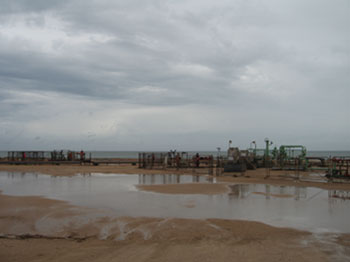
An approaching wet / cyclone season is often used by companies (as an invalid reason) to justify the need for a fast-tracked environmental assessment.
Timeframes can slip when companies submit applications that are deficient or missing information, requiring assessment officers to request additional information from proponents.
The iterative process of getting applications to the required standard results in the assessment 'clock' stopping. Likewise, formal referral to other agencies also stops the 'clock'. Some companies do not consider these factors when submitting their applications and panic when their anticipated assessment timeframes are exceeded.
There are a range of reasons that companies push when they want 'fast-tracked' environmental approvals. These include that the company will lose access to machinery, are paying standby costs, have a cyclone/wet season approaching, or the company has changed their priorities. This is poor project planning and is akin to pushing your way to the front of the queue at the supermarket checkout. It's clearly not acceptable and impacts upon companies doing the right thing.
However, there may be rare occasions when exceptional circumstances occur that require a project approval to be 'fast-tracked', including:
- Addressing a public safety hazard;
- To prevent significant environmental harm from occurring;
- In response to an emergency event;
- To address an administrative error previously made by DMP.
Any company request to 'fast-track' an environmental assessment must be submitted in writing to Dr Phil Gorey, Executive Director Environment with a valid reason.
Assessment timeframes for environmental approvals can be found here.
Four year PoW validity period
The State Government has extended the validity period for Programmes of Work (PoWs) from two to four years. PoW approvals ensure resource companies conduct exploration activities in an environmentally responsible manner, and will now give companies up to four years to complete approved exploration works.
The Department of Mines and Petroleum received 2569 PoW applications in 2012, and 1160 in the first half of 2013. This change will see a reduction in the number requiring annual review, and will deliver efficiencies for industry. Industry will have greater flexibility to manage exploration programs more efficiently. This includes unforeseen events such as extreme weather and access to operators, equipment and funding that can impact on an exploration work program. This decision avoids repeating work by both the company and the assessors in DMP when there is delay, while ensuring the highest environmental outcomes are maintained.
Please note: The new validity period only applies to new applications. All previous applications, approved prior to the change to the approval letters, are not subject to the four-year period. The simplest way for you to check the validity period of previous PoW applications is to check the period detailed within the original approval letter. If you should require more time to complete a program, an extension can be granted to increase the validity period.
Mine Closure Plan guideline review
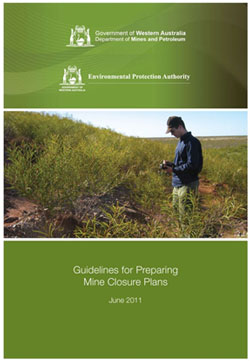
The Department of Mines and Petroleum, in conjunction with the Environmental Protection Authority (EPA), are undertaking a review and update of the Guidelines for Preparing Mine Closure Plans, 2011. The aim of the review is to improve the effectiveness and efficiency in mine closure planning and plan approval.
The guidelines were originally jointly prepared by DMP and the EPA, in consultation with stakeholders, to support amendments to the Mining Act 1978. At the time of their release, it was agreed that the document would be reviewed in 2013 with the final version of the new guidelines to be published in the middle of 2014.
From 11 November 2013 to 22 January 2014, stakeholders are invited to provide feedback on the guidelines.
A copy of the current guidelines can be accessed here.
Mining Legislation Amendment Bill 2013
The introduction to Parliament of the Mining Legislation Amendment Bill 2013 is the first step in a major revamp of WA's approvals systems. This first tranche of proposed law reforms is to make amendments to the Mining Act 1978 (Mining Act) and the Mining Rehabilitation Fund Act 2012 (MRF Act) to facilitate greater transparency by the Department of Mines and Petroleum, streamline the environmental approvals processes and strengthen compliance with this legislation.
The amendments are administrative in nature and will not adversely affect the day-to-day operations of tenement holders.
For further details on the bill please refer to the following documents;
Mining Legislation Amendment Bill 2013 - Exploration memorandum Mining Legislation Amendment Bill 2013On 30 October 2013, the Chamber of Minerals and Energy released a media statement supporting the Mining Legislative Amendment Bill, and more broadly the Reforming Environmental Regulation (RER) program initiative in DMP.
Mining Rehabilitation Fund update
The Mining Rehabilitation Fund, the new pooled fund that will largely replace unconditional performance bonds, commenced on a voluntary opt in basis from 1 July 2013.
So far over 950 tenement holders and groups have registered for the MRF.
The total value of voluntary payments into the levy is nearly $5 million. This is a clear indication that industry sees the benefit of the new system.
The Department has retired unconditional performance bonds worth over $230 million. This means companies have more money to reinvest in mining and exploration in the State. Some companies have used the money to invest in significant environmental rehabilitation on tenements.
The MRF team has been on the road to assist tenement holders register and report for the new MRF. This gave people the opportunity to use the department's expertise to help sign up for the MRF and, if eligible, have their existing bonds retired.
The MRF team has spent time in Kalgoorlie, Coolgardie, Karratha, Southern Cross and Bunbury. There has also been a lot of interest from tenement holders in other regional centres and the MRF team will look at heading back out in the New Year.
It is also important that people sign up for the fund before 30 June 2014, otherwise they run the risk of being fined for non-compliance. All tenement holders need to report disturbance data before 30 June each year, starting next year.
DMP has produced a fact sheet on eligibility criteria for voluntary entry into the MRF which outlines the process to register, opt in, enter disturbance data and request the retirement of unconditional performance bonds.
The department has also provided Frequently Asked Questions and a Guidance document to assist tenement holders with their reports. These and other additional information are available from the MRF information page on DMP's website.
For all enquiries about the MRF please email mrfenquiry@dmp.wa.gov.au or phone (08) 9222 3162.
2013-14 compliance
Over 2013-14, the Environment Division will conduct at least 100 audit and inspections of mining projects. The division will be targeting projects with the following attributes:
- Rehabilitation percentage low / little progressive rehabilitation;
- Closure planning poor / unexpected closure;
- Problematic materials in waste dump or Tailings Storage Facility (TSF); and
- Company history of non-compliance.
If your project fits into any of the above profiles, we suggest you conduct your own internal audit and alert the division to any potential non-compliance issues.
Approvals Performance Report
During the September quarter 2013, the Department of Mines and Petroleum's approval performance showed improvement across the majority of key approval processes.
The department's electronic information systems recorded a total of 948 mineral tenure applications comprising 543 exploration licences, 317 prospecting licences, 58 miscellaneous licences, 21 mining leases, six general purpose leases and three retention licences. The mineral title division finalised 95 per cent of mineral exploration licence applications and 89 per cent of prospecting licences within the target timeline of 65 business days.
This quarter, DMP received 526 mineral exploration and prospecting applications compared to 653 in the same period during 2012. Ninety-four per cent of mineral exploration "Programme of Work" applications were assessed within the target timeline of 30 business days. This was a significant improvement from the previous quarter where only 68 per cent of programmes of work were finalised. Consistent with DMP policy, one Programme of Work was fast tracked at the request of the proponent due to an immediate fire safety risk. Sixty-four per cent of mining proposals were finalised within the target of 30 business days, the same as the previous quarter.
Forty-seven native vegetation clearing permit applications were received by the Environment Division during this quarter. Seventy-five per cent of these applications were finalised within the target timeline of 60 calendar days. This improvement to the previous quarterly performance (49 per cent) is the result of the full implementation of a more risk based approach to the assessment process.
The department received 12 mine safety Project Management Plans (PMPs) and six Radiation Management Plans (RMPs) during the September quarter. One hundred per cent of PMPs and 80 per cent of RMPs were finalised within the target of 30 business days. RMP performance improved from 43 per cent in the previous quarter.
The department received 23 petroleum tenure and activity applications. Petroleum performance was below target with only 17 per cent of exploration permit applications finalised within the target time, 58 per cent of petroleum survey and 25 per cent of petroleum well applications finalised within 40 working days. DMP is reviewing petroleum assessment processes and procedures to improve performance. A total of 131 petroleum environment plans, bridging documents and oil spill contingency plans were received for planned petroleum activities in the State. Ninety-seven per cent of petroleum environmental plans were finalised within the target of 30 business days.
Analysis of online and paper mineral exploration licence applications
The chart below provides information about the number of mineral exploration licence applications finalised by DMP during the period from 1Q 2011 to 3Q 2013. The chart shows the proportion of online applications has steadily increased to around 50 per cent of the total number of applications.
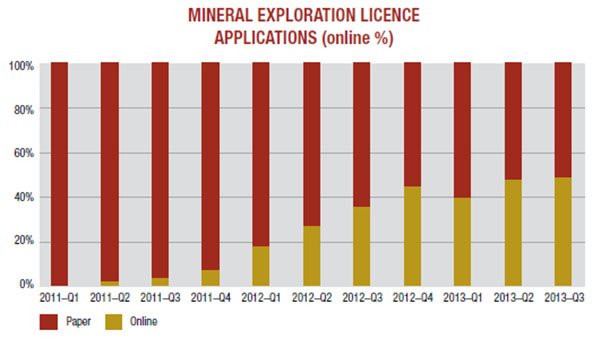
The average number of DMP processing days to finalise a mineral exploration application is shown for online lodgement (34 business days) and paper applications (69 business days). The approval timeline difference between an online and paper application is 35 business days or nearly two calendar months.
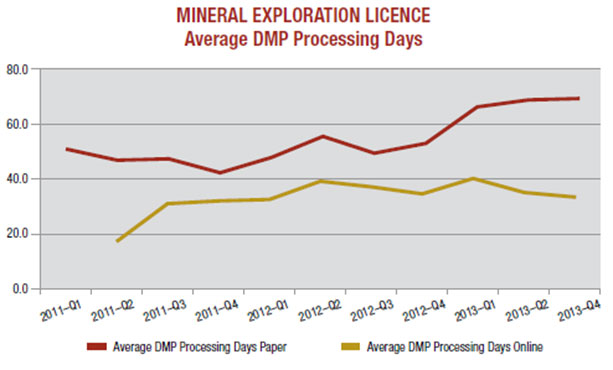
An average reduction of nearly two months in the DMP exploration licence timeline is a benefit of online lodgement for the WA mineral exploration industry. Other benefits of using online lodgement include reduced number of requests for additional information from DMP, the ability to track the progress of the application and increased certainty about when an application will be finalised. The above DMP timeline does not include the time taken by the native title expedited process.
DMP Approvals Performance – Third Quarter 2013
The below table provides information regarding the number of mining and petroleum applications received by the department during the specified period. DMP timeline target, approval performance measures and number of applications carried over to the next quarter are provided for key approval processes. The timeline target applies to processes completed by DMP and does not include, for example, the time taken for assessment by other government agencies or where the assessment process is put on hold while additional information is being sought from applicants.
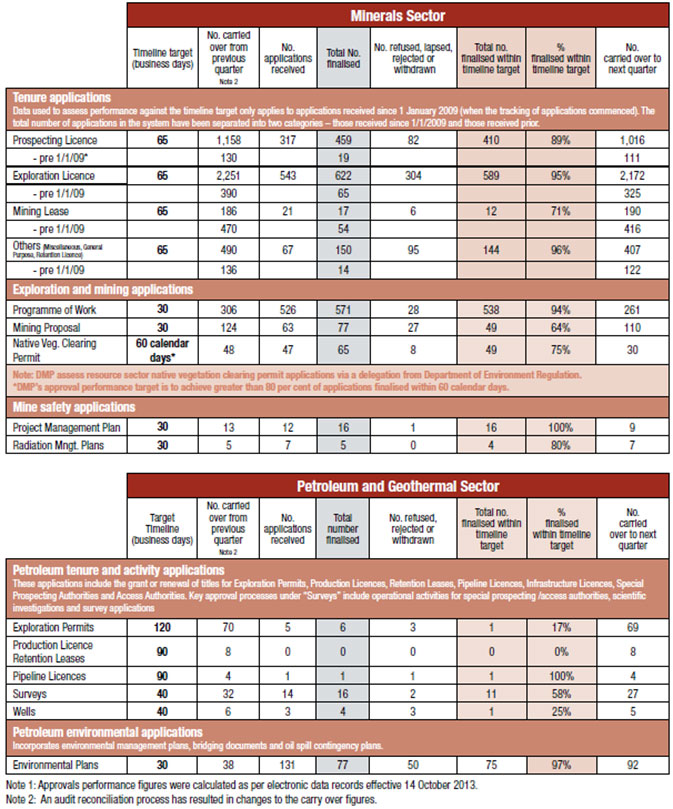
First Quarter to Third Quarter
This performance graph shows applications for approval and how they compare for each quarter since January 2013.
